January to March, 2025
Introduction
About the Ontario Employment Report
The Ontario Employment Report is released four times a year and provides an assessment of the current trends and developments in the Ontario labour market. The fourth quarter report is an annual report. The Ontario Employment Report is a companion report to the Ontario Economic Accounts, which provides an overall assessment of the current state of the Ontario economy.
Overview
Ontario’s labour market overview
Employment:
- +166,900 net jobs in Q1 2025, year-over-year
- +87,800 net full-time jobs in Q1 2025, year-over-year
- -27,500 net jobs in March 2025
- -31,700 net full-time jobs in March 2025
Unemployment rate:
- 7.6% in Q1 2025
- 7.5% in March 2025
Year-over-year, Ontario’s employment increased by 2.1% (+166,900) in the first quarter of 2025, while Canada’s employment grew by 1.9% (+389,600).
Ontario’s unemployment rate was 7.6% in the first quarter of 2025, higher than the Canadian rate of 6.9%.
In March 2025, Ontario’s employment decreased (-27,500, -0.3%), driven by declines in full-time employment (-31,700, -0.5%). Canada also experienced an employment decline in March 2025 (-32,600, -0.2%), driven by employment decreases in Ontario (-0.3%) and Alberta (-0.6%).
In March 2025, the unemployment rate in Ontario increased to 7.5% from 7.3% in February 2025. The unemployment rate in Canada also edged up to 6.7% from 6.6% in the previous month.
While Ontario’s unemployment rate has been increasing since its recent low of 5.0% in April 2023, the current unemployment rate for March 2025 (7.5%) is relatively consistent with the historical average (7.4%). This trending up in the unemployment rate is also observed at the national level, as Canada’s unemployment rate has increased from its recent low of 5.0% in March 2023 to 6.7% in March 2025.
Year-over-year overview
Ontario’s labour market, January 2015 – March 2025 (seasonally adjusted)
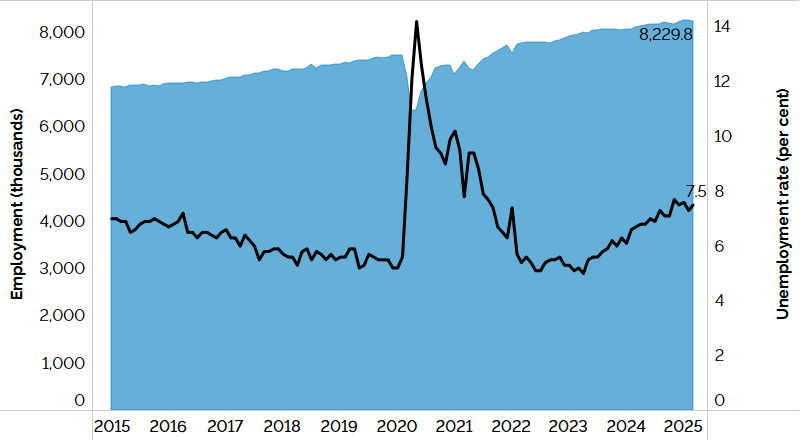
The combination line and area chart shows Ontario’s unemployment rate (line chart) and employment (area chart) from January 2015 to March 2025. Ontario’s unemployment rate trended downwards between January 2015 and January 2020, rose in early 2020 and declined afterwards. The rate has been trending up since mid-2023 reaching 7.5% in March 2025. Employment in Ontario had risen steadily before dropping in early 2020 and then gradually rising to about 8,229,800 workers in March 2025.
Between the first quarters of 2024 and 2025:
- Employment gains were driven by growth in both full-time employment (+1.3%) and part-time employment (+5.4%).
- Employment increased in all sectors: the private sector (+2.0%), the public sector (+1.3%) and the self-employed (+3.5%).
- Employment increased in services-producing industries (+2.6%) and stayed relatively unchanged in goods-producing industries (-0.1%).
- Employment increased in all five regions, with Northern Ontario (+3.1%) and the Greater Toronto Area (+2.9%) experiencing the highest rates of employment growth.
- Employment increased for youth (+6.0%) and core-aged workers (+2.2%), while employment of older workers (-0.3%) declined.
- Hourly wage growth (+3.8%) exceeded inflation (+2.2%).
Type of Work
Employment change by work status, Ontario, Q1 2025 over Q1 2024
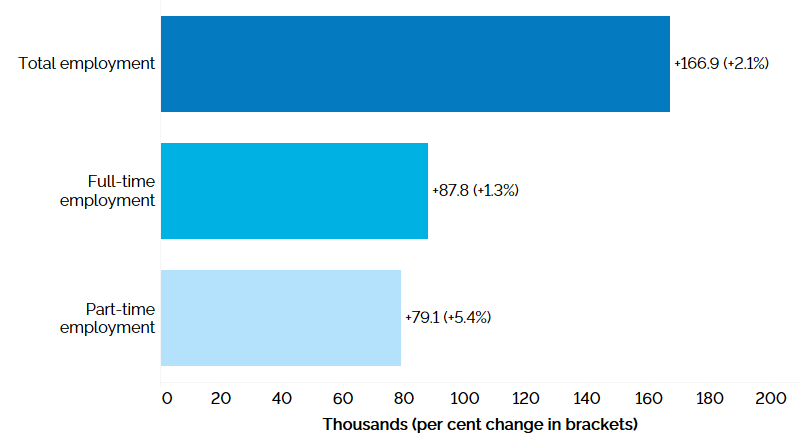
The horizontal bar chart shows a year-over-year (between the first quarters of 2024 and 2025) change in Ontario’s employment by full-time and part-time status. Total employment increased by 166,900 (+2.1%), with full-time employment increasing by 87,800 (+1.3%), and part-time employment increasing by 79,100 (+5.4%).
Year-over-year, full-time employment increased by 1.3% and part-time employment increased by 5.4% in the first quarter of 2025.
Employment change by employment sector, Ontario, Q1 2025 over Q1 2024
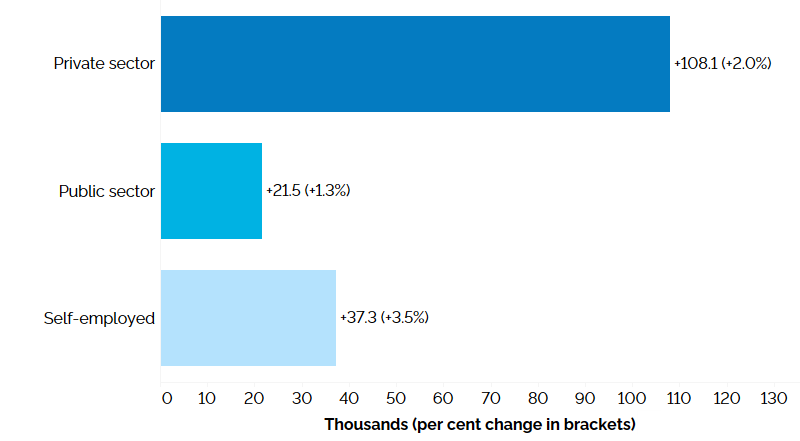
The horizontal bar chart shows a year-over-year (between the first quarters of 2024 and 2025) change in Ontario’s employment in the private sector, public sector and among the self-employed. Employment increased by 108,100 (+2.0%) in the private sector, by 21,500 (+1.3%) in the public sector and by 37,300 (+3.5%) among the self-employed.
Year-over-year, employment increased by 2.0% in the private sector, 1.3% in the public sector,
Sector and occupation
Employment change by industry, goods-producing industries, Ontario, Q1 2025 over Q1 2024
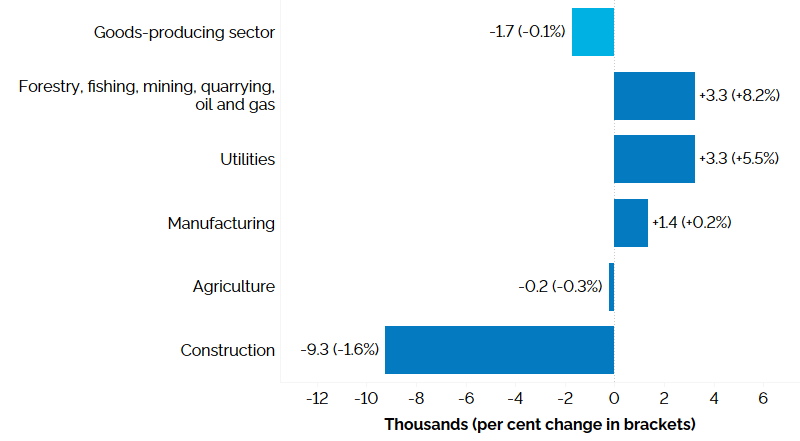
The horizontal bar chart shows a year-over-year (between the first quarters of 2024 and 2025) change in Ontario’s employment by industry for goods-producing industries, measured in thousands with percentage changes in brackets. Employment increased in three out of five goods-producing industries: forestry, fishing, mining, quarrying, oil and gas (+8.2%); utilities (+5.5%); and manufacturing (+0.2%). Employment declined in construction (-1.6%) and agriculture (-0.3%). The overall employment in goods-producing industries was relatively unchanged (-1,700, -0.1%).
Employment in goods-producing industries was relatively unchanged (-0.1%) in the first quarter of 2025, compared to the same period in 2024. Employment declines in construction (-1.6%) and agriculture (-0.3%) were mostly offset by increases in forestry, fishing, mining, quarrying, oil and gas (+8.2%), utilities (+5.5%), and manufacturing (+0.2%).
Employment change by industry, services-producing industries, Ontario, Q1 2025 over Q1 2024
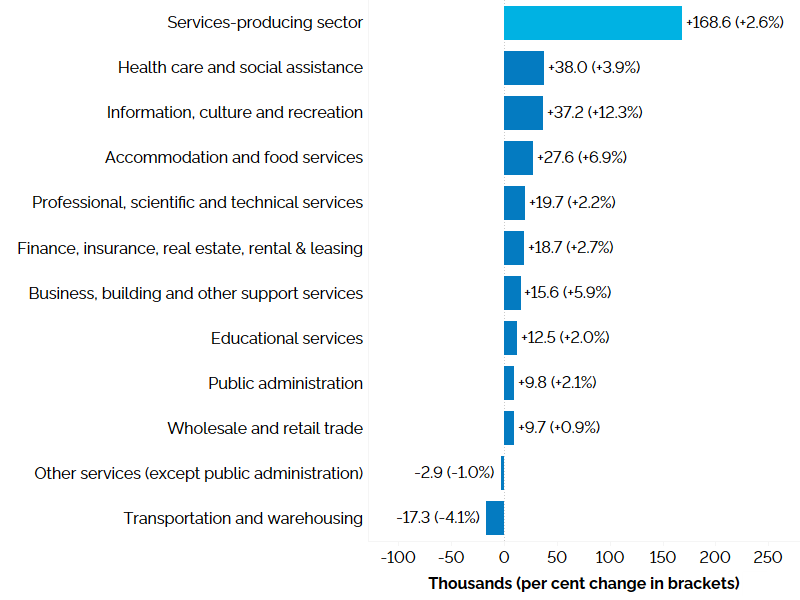
The horizontal bar chart shows a year-over-year (between the first quarters of 2024 and 2025) change in Ontario’s employment by industry for services-producing industries, measured in thousands with percentage changes in brackets. Employment increased in nine of the eleven services-producing industries. Health care and social assistance (+3.9%) experienced the largest increase in employment, followed by information, culture and recreation (+12.3%); accommodation and food services (+6.9%); professional, scientific and technical services (+2.2%); finance, insurance, real estate, rental and leasing (+2.7%); business, building and other support services (+5.9%); educational services (+2.0%); public administration (+2.1%); and wholesale and retail trade (+0.9%). Employment declined in other services (except public administration) (-1.0%) and transportation and warehousing (-4.1%). The overall employment in services-producing industries increased by 168,600 (+2.6%).
In the first quarter of 2025, employment in the services-producing industries (+2.6%) increased compared to the same period in 2024. All services-producing industries experienced employment growth except for transportation and warehousing (-4.1%) and other services (except public administration) (-1.0%). Health care and social assistance (+3.9%) experienced the largest employment gain, followed by information, culture and recreation (+12.3%) and accommodation and food services (+6.9%).
Employment change by occupational group, Ontario, Q1 2025 over Q1 2024footnote 2
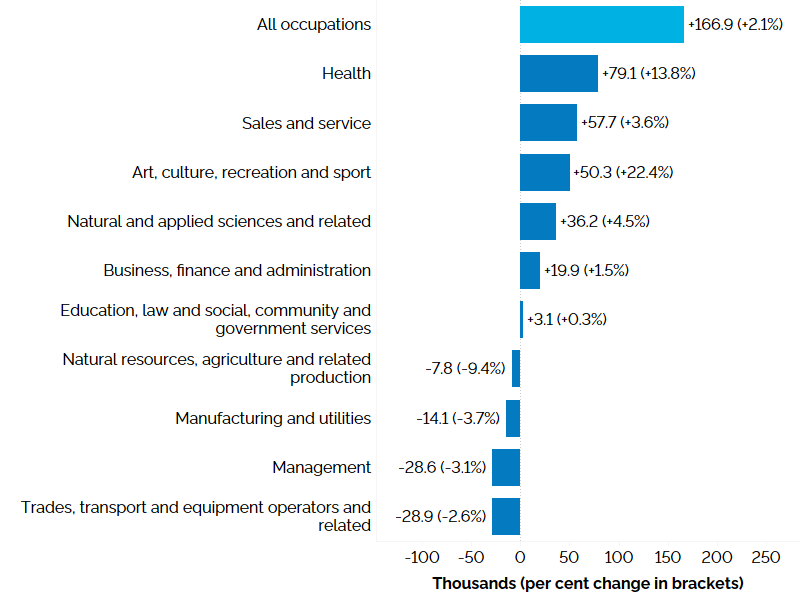
The horizontal bar chart shows a year-over-year (between the first quarters of 2024 and 2025) change in Ontario’s employment by broad occupational group, measured in thousands with percentage changes in brackets. Health occupations (+13.8%) experienced the largest employment increase followed by sales and service occupations (+3.6%); occupations in art, culture, recreation and sport (+22.4%); natural and applied sciences and related occupations (+4.5%); business, finance and administration occupations (+1.5%); and occupations in education, law and social, community and government services (+0.3%). Employment declined in natural resources, agriculture and related production occupations (-9.4%); occupations in manufacturing and utilities (-3.7%); management occupations (-3.1%); and trades, transport and equipment operators and related occupations (-2.6%).
Year-over-year, health occupations experienced the largest employment gain (+13.8%), followed by sales and service occupations (+3.6%) and occupations in art, culture, recreation and sport (+22.4%). Four of ten occupational groups experienced a decline in employment, led by trades, transport and equipment operators and related occupations (-2.6%).
Geographic region
Employment change by Ontario region, Q1 2025 over Q1 2024footnote 3
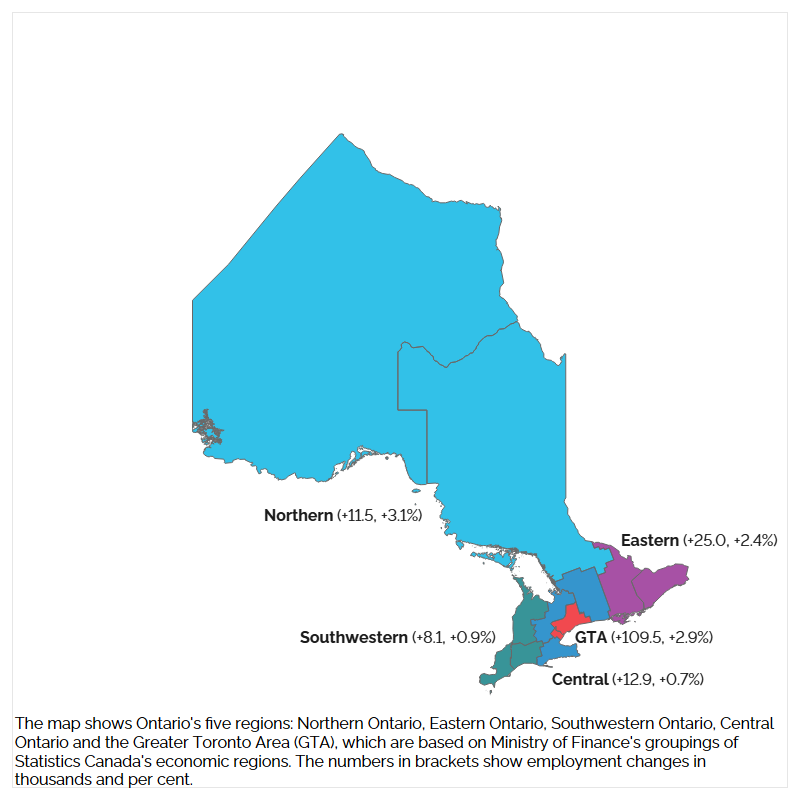
The map shows Ontario's five regions: Northern Ontario, Eastern Ontario, Southwestern Ontario, Central Ontario and the Greater Toronto Area (GTA), which are based on Ministry of Finance's groupings of Statistics Canada's economic regions. The numbers in brackets show employment changes in thousands and percentages between the first quarters of 2024 and 2025. Employment increased in all five regions led by the GTA (+109,500, +2.9%), Eastern Ontario (+25,000, +2.4%), Central Ontario (+12,900, +0.7%), Northern Ontario (+11,500, +3.1%), and Southwestern Ontario (+8,100, +0.9%).
Year-over-year, employment increased in all five Ontario regions in the first quarter of 2025. The Greater Toronto Area (GTA)
Unemployment rates by Ontario region, Q1 2025footnote 5

The horizontal bar chart shows unemployment rates by Ontario region in the first quarter of 2025 with percentage point changes from the first quarter of 2024 in brackets. The Greater Toronto Area had the highest unemployment rate at 8.7% (+1.4 percentage points compared to the first quarter of 2024), followed by Central Ontario at 7.3% (+1.0 percentage point), Southwestern Ontario at 6.9% (+0.8 percentage point), Eastern Ontario at 5.6% (+0.4 percentage point), and Northern Ontario at 5.0% (-1.1 percentage points). The overall unemployment rate for Ontario was 7.6% (+1.0 percentage point).
In the first quarter of 2025, the unemployment rate increased in all regions, except for Northern Ontario (-1.1 percentage points). The GTA had the highest unemployment rate (8.7%), followed by Central Ontario (7.3%), Southwestern Ontario (6.9%), Eastern Ontario (5.6%), and Northern Ontario (5.0%).
Age and gender
Employment change by age group and gender, Ontario, Q1 2025 over Q1 2024
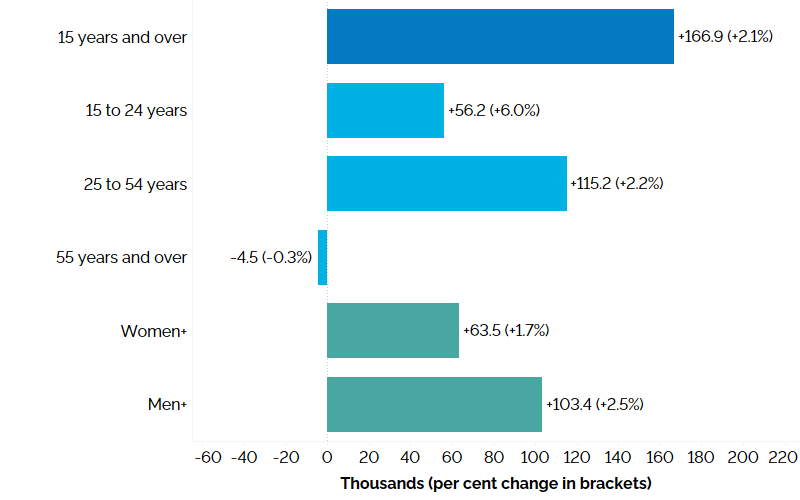
The horizontal bar chart shows a year-over-year (between the first quarters of 2024 and 2025) change in Ontario’s employment for the three major age groups, as well as by gender, compared to the overall population. This is measured in thousands with percentage changes in brackets. Employment increased among core-aged workers aged 25 to 54 years (+115,200, +2.2%) and youth aged 15 to 24 years (+56,200, +6.0%), but declined among older workers aged 55 years and over (-4,500, -0.3%). Women+ employment increased by 63,500 (+1.7%) and men+ employment increased by 103,400 (+2.5%). Total employment increased by 166,900 (+2.1%).
Compared to the same quarter last year, employment increased for core-aged workers aged 25 to 54 years (+2.2%) and youth aged 15 to 24 years (+6.0%). Older workers aged 55 years and over experienced a decline in employment (-0.3%).
Year-over-year, employment increased both for women (+1.7%) and men (+2.5%)
Unemployment rates by age group and gender, Ontario, Q1 2025
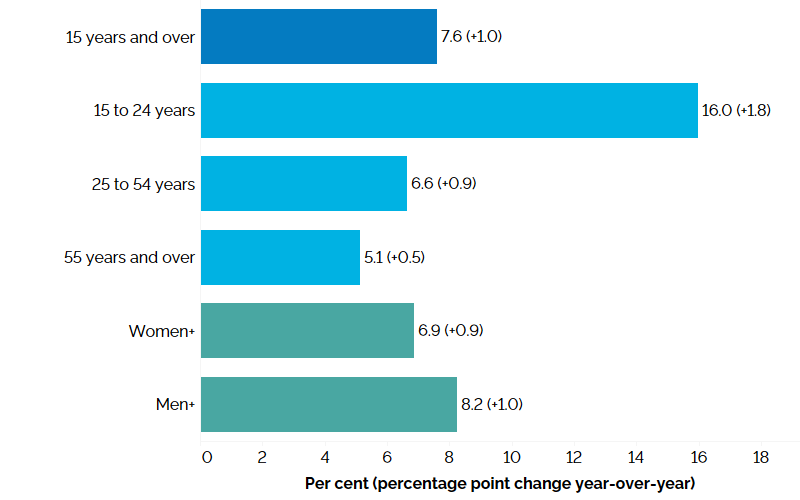
The horizontal bar chart shows unemployment rates in the first quarter of 2025 by major age group and by gender with percentage point changes from the first quarter of 2024 in brackets. Ontario’s overall unemployment rate in the first quarter of 2025 was 7.6% (+1.0 percentage point compared to the first quarter of 2024). Youth aged 15 to 24 years had the highest unemployment rate at 16.0% (+1.8 percentage points), followed by the core-aged population aged 25 to 54 years at 6.6% (+0.9 percentage point) and older workers aged 55 years and over at 5.1% (+0.5 percentage point). The women+ unemployment rate was 6.9% (+0.9 percentage point) and the men+ unemployment rate was 8.2% (+1.0 percentage point).
In the first quarter of 2025, youth had the highest unemployment rate (16.0%), followed by core-aged individuals (6.6%) and older individuals (5.1%). Compared to the same period last year, the unemployment rate increased for all age groups, but the increase was most pronounced among youth.
In the first quarter of 2025, the unemployment rate for men (8.2%) was higher than that of women (6.9%). Compared to the same period last year, the unemployment rate increased by 0.9 percentage point for women and 1.0 percentage point for men.
Education level and immigrant status
Employment rates by education level and immigrant status (core-aged population), Ontario, Q1 2025footnote 7
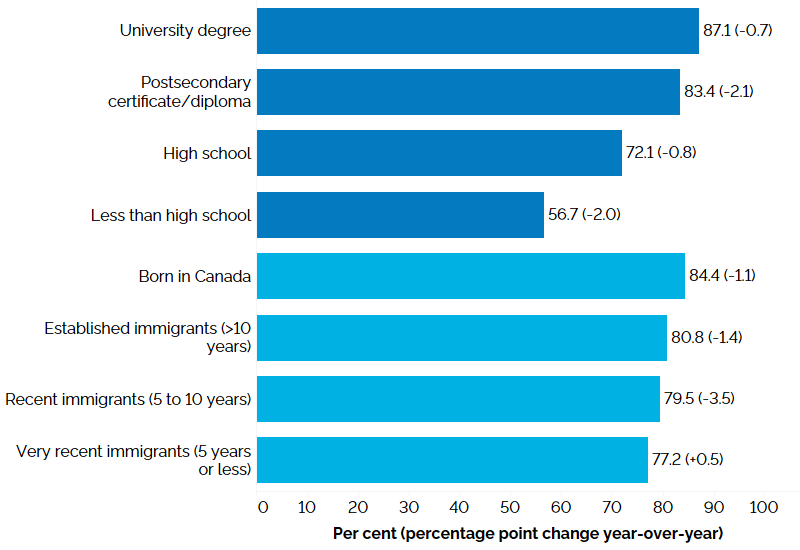
The horizontal bar chart shows employment rates by education level and immigrant status for the core-aged population (25 to 54 years), in the first quarter of 2025, with percentage point changes from the first quarter of 2024 in brackets. By education level, those with a university degree had the highest employment rate (87.1%, -0.7 percentage point), followed by those with a postsecondary certificate/diploma (83.4%, -2.1 percentage points), those with a high school diploma (72.1%, -0.8 percentage point), and those with less than high school education (56.7%, -2.0 percentage points). By immigrant status, those born in Canada had the highest employment rate (84.4%, -1.1 percentage points), followed by established immigrants with more than 10 years since landing (80.8%, -1.4 percentage points), recent immigrants with 5 to 10 years since landing (79.5%, -3.5 percentage points), and very recent immigrants with 5 years or less since landing (77.2%, +0.5 percentage point).
In the first quarter of 2025, core-aged individuals with less than high school education
Year-over-year, the employment rate for core-aged people decreased across all four education levels.
Core-aged persons born in Canada had the highest employment rate (84.4%), while very recent immigrants had the lowest employment rate (77.2%).
Year-over-year, the employment rate decreased for the core-aged population born in Canada, established immigrants and recent immigrants, while it increased for very recent immigrants.
Unemployment rates by education level and immigrant status (core-aged population), Ontario, Q1 2025footnote 9
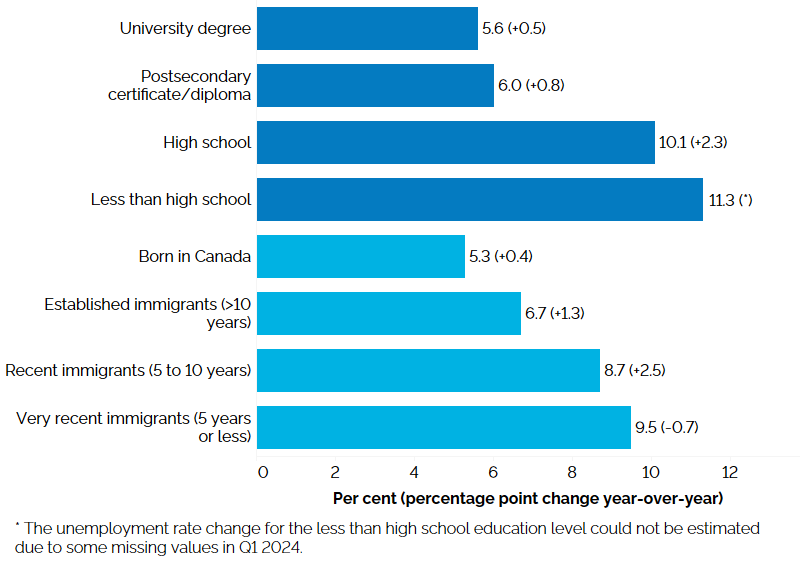
The horizontal bar chart shows unemployment rates by education level and immigrant status for the core-aged population (25 to 54 years), in the first quarter of 2025, with percentage point changes from the first quarter of 2024 in brackets. By education level, those with less than high school education had the highest unemployment rate (11.3%, percentage point change from the first quarter of 2024 could not be estimated due to some missing values in Q1 2024), followed by those with high school education (10.1%, +2.3 percentage points), those with a postsecondary certificate or diploma (6.0%, +0.8 percentage point) and university degree holders (5.6%, +0.5 percentage point). By immigrant status, very recent immigrants with 5 years or less since landing had the highest unemployment rate (9.5%, -0.7 percentage point), followed by recent immigrants with 5 to 10 years since landing (8.7%, +2.5 percentage points), established immigrants with more than 10 years since landing (6.7%, +1.3 percentage points), and those born in Canada (5.3%, +0.4 percentage point).
In the first quarter of 2025, the core-aged population with a university degree and those with a postsecondary certificate or diploma had the lowest unemployment rates (5.6% and 6.0%, respectively). Those with a high school diploma (10.1%) and less than high school education (11.3%) had higher unemployment rates. Year-over-year, the unemployment rate of core-aged people increased across all education levels.
In the first quarter of 2025, the core-aged population born in Canada had the lowest unemployment rate (5.3%), while very recent immigrants had the highest unemployment rate (9.5%). Year-over-year, the unemployment rate increased for all groups by immigrant status, except for very recent immigrants.
Wages
Average hourly wage growth by type of work, Ontario, Q1 2025 over Q1 2024footnote 10

The vertical bar chart shows a year-over-year (between the first quarters of 2024 and 2025) per cent change in Ontario’s nominal hourly wages by type of work. The average hourly wage increased by 3.8%. Average hourly wages increased for full-time employees (+3.8%) and for part-time employees (+5.2%). Average hourly wages increased for permanent employees (+3.9%) and temporary employees (+3.4%). Average hourly wages increased for employees with union coverage (+5.5%) and those without union coverage (+3.0%). Inflation during the same period was 2.2%.
In the first quarter of 2025, the average hourly wage of Ontario employees was $37.32, an increase of 3.8% from the first quarter of 2024
Full-time employees (+3.8%), part-time employees (+5.2%), permanent employees (+3.9%), temporary employees (+3.4%), employees with union coverage (+5.5%) and those without union coverage (+3.0%) all experienced increases in average hourly wages.
Methodological note
In the current issue, year-over-year change represents change between the averages in the first quarter of 2024 and the first quarter of 2025. Note that the Ontario Economic Accounts report primarily shows changes between two consecutive quarters.
This report uses seasonally adjusted data in charts displaying data with a monthly frequency in the Overview section.
Unadjusted data are used in charts and tables showing the changes for the current quarter compared with the same quarter for the previous year. Unadjusted data are also used to calculate annual averages, year-to-date averages and 2025 first quarter averages
All estimates in this report are based on Statistics Canada’s Labour Force Survey (LFS), which measures the current state of the national, provincial, and territorial labour market. The LFS is based on a household survey carried out monthly by Statistics Canada in reference weeks of each month. The reference periods for the three months of the first quarter of 2025 are January 12 to 18, February 9 to 15, and March 9 to 15.
Appendix I
Overview of quarterly employment year-over-year, Ontario
| 2023Q2 | 2024Q2 | 2023Q3 | 2024Q3 | 2023Q4 | 2024Q4 | 2024Q1 | 2025Q1 | |
|---|---|---|---|---|---|---|---|---|
| Total Labour Force (000) | 8,517.0 | 8,806.5 | 8,606.1 | 8,881.5 | 8,524.0 | 8,777.9 | 8,552.8 | 8,825.7 |
| Participation Rate (%) | 66.2 | 65.9 | 66.3 | 65.8 | 65.1 | 64.6 | 64.6 | 64.7 |
| Men+ Participation Rate (%) | 70.8 | 70.3 | 71.0 | 70.5 | 69.5 | 69.2 | 68.9 | 69.1 |
| Women+ Participation Rate (%) | 61.8 | 61.5 | 61.7 | 61.2 | 60.8 | 60.2 | 60.5 | 60.4 |
| Total Employment (000) | 8,058.5 | 8,202.2 | 8,068.5 | 8,217.2 | 8,049.0 | 8,176.6 | 7,988.6 | 8,155.5 |
| - Full-time (000) | 6,666.8 | 6,756.5 | 6,770.5 | 6,847.6 | 6,629.1 | 6,704.3 | 6,535.7 | 6,623.6 |
| - Part-time (000) | 1,391.8 | 1,445.7 | 1,298.0 | 1,369.6 | 1,419.9 | 1,472.4 | 1,452.8 | 1,531.9 |
| Employment-Population Ratio (%) | 62.7 | 61.4 | 62.2 | 60.9 | 61.4 | 60.2 | 60.4 | 59.8 |
| Men+ Employment (000) | 4,261.8 | 4,319.1 | 4,301.7 | 4,364.1 | 4,243.1 | 4,322.3 | 4,187.5 | 4,290.9 |
| Women+ Employment (000) | 3,796.7 | 3,883.1 | 3,766.8 | 3,853.1 | 3,805.9 | 3,854.3 | 3,801.1 | 3,864.6 |
| Part Time (% of total) | 17.3 | 17.6 | 16.1 | 16.7 | 17.6 | 18 | 18.2 | 18.8 |
| Goods-Producing Sector Employment (000) | 1,639.8 | 1,600.3 | 1,670.7 | 1,613.9 | 1,610.9 | 1,562.6 | 1,557.3 | 1,555.6 |
| Services-Producing Sector Employment (000) | 6,418.7 | 6,601.8 | 6,397.8 | 6,603.3 | 6,438.1 | 6,614.0 | 6,431.3 | 6,599.9 |
| Private Sector Employment (000) | 5,427.9 | 5,473.2 | 5,459.4 | 5,520.7 | 5,346.1 | 5,400.6 | 5,292.2 | 5,400.3 |
| Public Sector Employment | 1,572.3 | 1,633.6 | 1,542.7 | 1,582.3 | 1,608.9 | 1,650.3 | 1,622.4 | 1,643.9 |
| Self-Employment (% of total) | 13.1 | 13.4 | 13.2 | 13.6 | 13.6 | 13.8 | 13.4 | 13.6 |
| Total Unemployment (000) | 458.5 | 604.3 | 537.6 | 664.3 | 474.9 | 601.3 | 564.2 | 670.1 |
| Unemployment Rate (%) | 5.4 | 6.9 | 6.2 | 7.5 | 5.6 | 6.9 | 6.6 | 7.6 |
| Men+ Unemployment Rate (%) | 5.2 | 7.3 | 5.5 | 7.5 | 5.7 | 7.3 | 7.2 | 8.2 |
| Women+ Unemployment Rate (%) | 5.6 | 6.4 | 7.0 | 7.4 | 5.4 | 6.4 | 5.9 | 6.9 |
| Long-Term (27 wks+) (% of total) | 17.2 | 21.2 | 14.1 | 20.3 | 19.4 | 27.8 | 20.4 | 26.9 |
| Average Unemployment in Weeks | 17.8 | 19.1 | 16.4 | 19.8 | 18.5 | 25.0 | 19.9 | 24.2 |
| Youth Unemployment Rate (%) | 13.1 | 16.6 | 13.2 | 16.6 | 12.5 | 15.0 | 14.2 | 16.0 |
| 25-54 y.o Unemployment Rate (%) | 4.3 | 5.5 | 5.3 | 6.1 | 4.6 | 5.9 | 5.7 | 6.6 |
| 55+ y.o Unemployment Rate (%) | 3.3 | 4.5 | 4.3 | 5.2 | 4.2 | 4.5 | 4.7 | 5.1 |
| Average Weekly Wage Rate ($) | 1,265.13 | 1,314.51 | 1,289.23 | 1,354.92 | 1,306.36 | 1,368.65 | 1,317.60 | 1,361.93 |
| Average Hourly Wage Rate ($) | 34.25 | 35.76 | 34.72 | 36.60 | 35.48 | 37.43 | 35.96 | 37.32 |
Employment by Region (000)
| Region | 2023Q2 | 2024Q2 | 2023Q3 | 2024Q3 | 2023Q4 | 2024Q4 | 2024Q1 | 2025Q1 |
|---|---|---|---|---|---|---|---|---|
| Central | 1,900.2 | 1,920.7 | 1,897.7 | 1,909.5 | 1,887.4 | 1,901.8 | 1,871.9 | 1,884.8 |
| Southwestern | 907.8 | 949.3 | 915.8 | 943.1 | 912.3 | 945.8 | 923.2 | 931.3 |
| Eastern | 1,054.5 | 1,067.4 | 1,061.2 | 1,091.4 | 1,067.2 | 1,085.7 | 1,045.3 | 1,070.3 |
| Northern | 378.6 | 383.9 | 377.9 | 388.8 | 378.1 | 379.3 | 369.3 | 380.8 |
| Greater Toronto Area (GTA) | 3,817.6 | 3,880.9 | 3,815.9 | 3,884.4 | 3,804.1 | 3,863.9 | 3,778.9 | 3,888.4 |
Unemployment Rate by Region (%)
| Region | 2023Q2 | 2024Q2 | 2023Q3 | 2024Q3 | 2023Q4 | 2024Q4 | 2024Q1 | 2025Q1 |
|---|---|---|---|---|---|---|---|---|
| Central | 4.8 | 6.0 | 5.4 | 6.3 | 5.3 | 6.3 | 6.3 | 7.3 |
| Southwestern | 5.1 | 6.0 | 6.0 | 7.2 | 5.6 | 6.2 | 6.1 | 6.9 |
| Eastern | 4.4 | 5.8 | 5.4 | 6.4 | 4.1 | 5.4 | 5.2 | 5.6 |
| Northern | 4.6 | 5.0 | 5.4 | 5.8 | 5.3 | 5.4 | 6.1 | 5.0 |
| Greater Toronto Area (GTA) | 6.1 | 7.9 | 7.0 | 8.6 | 6.1 | 7.8 | 7.3 | 8.7 |
Total Employment by CMA (000)
Greater Toronto Area
| 2023Q2 | 2024Q2 | 2023Q3 | 2024Q3 | 2023Q4 | 2024Q4 | 2024Q1 | 2025Q1 | |
|---|---|---|---|---|---|---|---|---|
| Toronto | 3,646.9 | 3,697.1 | 3,637.7 | 3,697.4 | 3,620.1 | 3,682 | 3,601.2 | 3,720.6 |
| Oshawa | 234.0 | 245.9 | 233.9 | 239.6 | 238.8 | 239.7 | 244.0 | 247.3 |
Central Ontario
| 2023Q2 | 2024Q2 | 2023Q3 | 2024Q3 | 2023Q4 | 2024Q4 | 2024Q1 | 2025Q1 | |
|---|---|---|---|---|---|---|---|---|
| Hamilton | 424.4 | 437.0 | 422.9 | 434.8 | 431.0 | 430.8 | 430.8 | 419.4 |
| Kitchener-Cambridge-Waterloo | 357.2 | 387.1 | 365.9 | 378.7 | 365.5 | 389.6 | 370.5 | 385.7 |
| St. Catharines-Niagara | 230.3 | 229.8 | 236.4 | 241.3 | 239.1 | 242.5 | 220.4 | 237.4 |
| Peterborough | 64.4 | 65.6 | 72.7 | 66.3 | 73.1 | 70.7 | 64.6 | 68.3 |
| Brantford | 84.6 | 86.6 | 83.9 | 82.6 | 85.2 | 85.5 | 86.0 | 83.4 |
| Guelph | 106.0 | 107.4 | 102.2 | 99.1 | 105.6 | 97.9 | 107.6 | 100.1 |
| Barrie | 143.6 | 134.7 | 136.0 | 137.5 | 128.6 | 130.8 | 126.2 | 125.2 |
Eastern Ontario
| 2023Q2 | 2024Q2 | 2023Q3 | 2024Q3 | 2023Q4 | 2024Q4 | 2024Q1 | 2025Q1 | |
|---|---|---|---|---|---|---|---|---|
| Ottawa-Gatineau (Ontario part) | 678.8 | 686.8 | 687.3 | 703.5 | 687.6 | 702.3 | 680.2 | 705.5 |
| Kingston | 96.3 | 95.7 | 94.0 | 92.3 | 90.8 | 96.0 | 89.0 | 96.6 |
| Belleville - Quinte West | 70.5 | 50.4 | 64.2 | 51.7 | 50.0 | 35.1 | 42.2 | 31.7 |
Southwestern Ontario
| 2023Q2 | 2024Q2 | 2023Q3 | 2024Q3 | 2023Q4 | 2024Q4 | 2024Q1 | 2025Q1 | |
|---|---|---|---|---|---|---|---|---|
| London | 316.2 | 326.2 | 323.7 | 320.7 | 321.0 | 322.3 | 316.7 | 324.2 |
| Windsor | 235.7 | 241.9 | 234.3 | 239.7 | 228.7 | 237.8 | 229.6 | 241.4 |
Northern Ontario
| 2023Q2 | 2024Q2 | 2023Q3 | 2024Q3 | 2023Q4 | 2024Q4 | 2024Q1 | 2025Q1 | |
|---|---|---|---|---|---|---|---|---|
| Greater Sudbury | 91.5 | 87.9 | 89.5 | 91.0 | 93.0 | 91.9 | 89.9 | 92.6 |
| Thunder Bay | 66.0 | 66.2 | 65.9 | 66.5 | 64.0 | 65.3 | 62.2 | 63.3 |
Overview of monthly* labour force characteristics, Ontario
| Jan-24 | Feb-24 | Mar-24 | Apr- 24 | May-24 | Jun-24 | Jul-24 | Aug-24 | Sept-24 | Oct-24 | Nov-24 | Dec-24 | Jan-25 | Feb-25 | Mar-25 | |
|---|---|---|---|---|---|---|---|---|---|---|---|---|---|---|---|
| Employment | 8,063.9 | 8,066.6 | 8,095.5 | 8,118.1 | 8,144.3 | 8,157.4 | 8,171.9 | 8,163.0 | 8,197.6 | 8,178.7 | 8,169.7 | 8,201.4 | 8,240.4 | 8,257.3 | 8,229.8 |
| Unemployment rate | 6.1 | 6.6 | 6.7 | 6.8 | 6.8 | 7.0 | 6.9 | 7.3 | 7.1 | 7.1 | 7.7 | 7.5 | 7.6 | 7.3 | 7.5 |
| Participation rate | 65.1 | 65.2 | 65.4 | 65.4 | 65.4 | 65.4 | 65.2 | 65.2 | 65.2 | 64.9 | 65.2 | 65.2 | 65.4 | 65.3 | 65.1 |
* Seasonally adjusted.
Footnotes
- footnote[1] Back to paragraph The public sector includes employees in federal, provincial, territorial, municipal and Aboriginal public administrations, as well as in Crown corporations, liquor control boards and other government institutions such as schools (including universities), hospitals and public libraries.
- footnote[2] Back to paragraph Occupation estimates are based on the 2021 National Occupational Classification. Management occupations are classified under the management occupational category and the remaining categories exclude management occupations.
- footnote[3] Back to paragraph Based on a three-month moving average for March 2025, using unadjusted data.
- footnote[4] Back to paragraph The GTA refers to the Statistics Canada definition of the Toronto Economic Region; notably, this definition excludes the city of Burlington.
- footnote[5] Back to paragraph Based on a three-month moving average for March 2025, using unadjusted data. The seasonally adjusted estimate for Ontario in Q1 2025 is 7.5%.
- footnote[6] Back to paragraph Changes have been introduced to the LFS microdata starting in January 2022 to use gender (men+, women+) instead of sex of person (male, female). The category “Men+” includes men and boys, as well as some non-binary persons, while the category “Women+” includes women and girls, as well as some non-binary persons. Given that the non-binary population is small, data aggregation to a two-category gender variable is necessary to protect the confidentiality of responses provided.
- footnote[7] Back to paragraph Rate by immigrant status is based on a three-month moving average for March 2025. Education level refers to the highest level of schooling completed.
- footnote[8] Back to paragraph The less than high school population includes those with 0 to 8 years of education and those with some high school education.
- footnote[9] Back to paragraph Rate by immigrant status is based on a three-month moving average for March 2025. Education level refers to the highest level of schooling completed. The unemployment rate change for the less than high school education level could not be estimated due to some missing values in Q1 2024.
- footnote[10] Back to paragraph Nominal wage growth, not adjusted for inflation. Self-employment is excluded. Inflation is measured as an increase in the all-items Consumer Price Index for Ontario between January and March 2024 and January and March 2025.
- footnote[11] Back to paragraph Year-over-year comparison (between first quarters of 2024 and 2025) is in nominal dollars.
- footnote[12] Back to paragraph Estimates of employment changes and rate calculations are based on unrounded quarterly estimates and may differ slightly from estimates based on published quarterly data due to rounding.